Littlewood, Peter Ronald Benjamin (Flying Officer)
Killed in Action 1943-07-30


Birth Date: 1921
Born:
Son of Lancelot E. and Edith Gladys Littlewood, of Saanichton, Vancouver Island, British Columbia.
Home: Vermillion, Alberta
Enlistment:
Enlistment Date: Unknown
Service
RAF
Unit
410 Sqn- Squadron
Noctivaga Wandering by Night
Base
Rank
Flying Officer
Position
Flying Officer
Service Numbers
126814
Home
 Vermillion, Alberta
Vermillion, Alberta
Airspeed Oxford
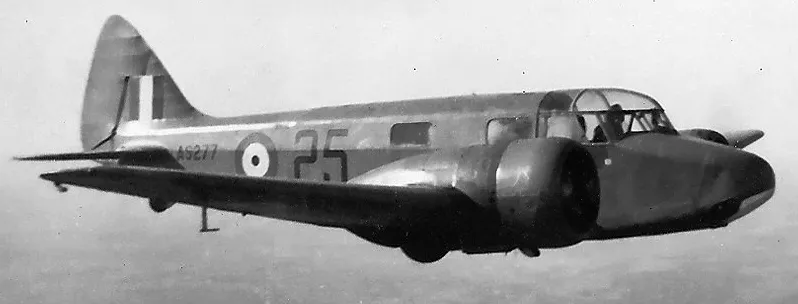
Airspeed A.S. 10 Oxford Mk. II, RCAF (Serial No. AS277), 25, in flight over Saskatchewan, 1942.
The Airspeed AS.10 Oxford was a twin-engine monoplane aircraft developed and manufactured by Airspeed. It saw widespread use for training British Commonwealth aircrews in navigation, radio-operating, bombing and gunnery roles throughout the Second World War.
The Oxford was developed by Airspeed during the 1930s in response to a requirement for a capable trainer aircraft that conformed with Specification T.23/36, which had been issued by the British Air Ministry. Its basic design is derived from the company's earlier AS.6 Envoy, a commercial passenger aircraft. Performing its maiden flight on 19 June 1937, it was quickly put into production as part of a rapid expansion of the Royal Air Force (RAF) in anticipation of a large-scale conflict.
As a consequence of the outbreak of war, many thousands of Oxfords were ordered by Britain and its allies, including Australia, Canada, France, New Zealand, Poland, and the United States. Following the end of the conflict, the Oxford continued to achieve export sales for some time, equipping the newly formed air forces of Egypt, India, Israel, and Yugoslavia. It was considered to be a capable trainer aircraft throughout the conflict, as well as being used a general-purpose type. A large number of Oxfords have been preserved on static display.Wikipedia
410 Sqn Noctivaga ("Cougar")
History of the Squadron during World War II (Aircraft: Defiant IF, Beaufighter IIF, Mosquito NF II, FB VI, NF XIII,)
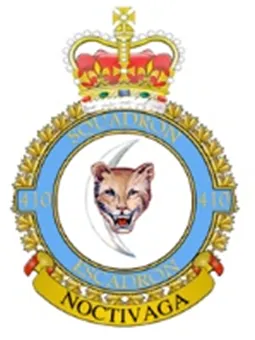
The Squadron was formed at Ayr, Scotland on June 30, 1941 as the RCAF's third Night Fighter squadron to be formed overseas in WWII. It was the ninth RCAF squadron formed overseas. The squadron flew Boulton Paul Defiant, Bristol Beaufighter and later de Havilland Mosquito aircraft in the night air defence of Britain, and then Europe. It was based at a number of locations in the UK before moving to Europe in September 1944, where it remained until the end of hostilities. It was disbanded at Gilze-Rijen, the Netherlands , on June 9, 1945.
In the course of the conflict, the squadron flew 2972 sorties and accounted for 75 enemy aircraft confirmed destroyed, with 2 probables and 9 damaged. Operational casualties were 17 aircraft and 32 aircrew, of whom 10 were killed, 20 presumed killed and 2 POW. The squadron had 10 aces (shot down 5 or more enemy aircraft), of whom 4 were pilots and the others navigators: kills were credited to both crew members (Flight Lieutenant R.D. Schultz DFC&Bar; Flying Officer D.G. Tonque, RAF DFC&Bar (Nav.); Lieutenant A.A. Harrington (USAAF) DSO,DFC; Flight Lieutenant C.E. Edinger DFC; Flying Officer J.S. Christie (RAF) DFC (Nav.); Flying Officer C.L. Vaessen DFC (Nav.); Flight Lieutenant G.P.A. Bodard DFC (Nav.); Squadron Leader J.D. Somerville DSO, DFC; Flying Officer G.D. Robinson DFC (Nav.); Flight Lieutenant V.A. Williams DFC (Nav.). The squadron won 1 DSO, 1 MBE, 2 Bars to DFC, 19 DFCs, 1 BEM and 17 Mentioned in Dispatches. Battle Honours were: Defence of Great Britain 1941-44, Fortress Europe 1943, France and Germany 1944-45 Normandy 1944, Rhine, Biscay 1943.Wikipedia, Kostenuk and Griffin
Maps for Movements of 410 Squadron 1941-45
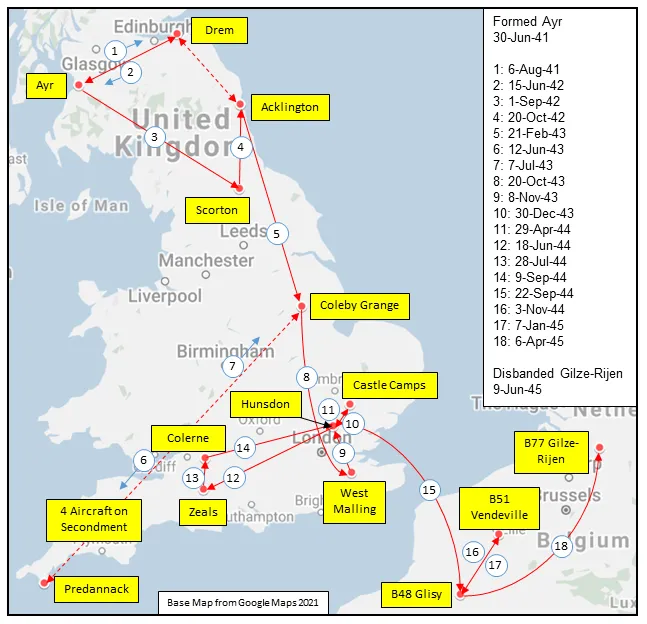
410 Squadron History Summary 1941-45

410 Squadron History Summary 1941-45 Page 2
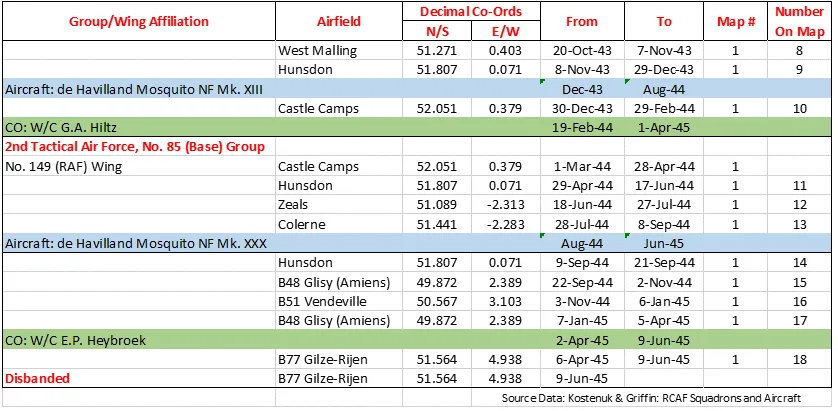
History of the Squadron Post-WWII (Aircraft: Vampire III, Sabre 2, CF-100, Voodoo, Hornet)
The squadron was re-formed in a Fighter role at St Hubert (Montreal), Quebec on 1 December 1948. It was the first post-war Regular Force fighter unit, the first to fly Vampire and Sabre aircraft, and the first to join No. 1 (Fighter) Wing of No. 1 Air Division Europe. In 1956, it was decided to replace one Sabre squadron in each of the Air Division’s four wings with an all-weather fighter unit. When No. 445 AW(F) Squadron arrived from Canada, No. 410 was deactivated at Marville, France on 1 October 1956 and reactivated as All-Weather (Fighter) at Uplands (Ottawa), Ontario on 1 November. The squadron flew CF-100 and CF-101 aircraft on North American air defence until being disbanded on 1 April 1964.
In 1968, No.3 (Operating Training Unit) at CFB Bagotville, Quebec , which was tasked with training pilots and navigators for the three operational RCAF Voodoo squadrons, was renamed No. 410 Squadron. It moved to Cold Lake, Alberta in 1982, changing aircraft to become the training unit for Canada's new CF-18 Hornet aircraft. The squadron’s mission is: To Train World Class Fighter Pilots to Meet Canada's Needs.
The squadron runs two ab initio Fighter Pilot Courses (FPC) each year, training up to 20 fighter pilots. Each course comprises seven intense months of academics, simulator flights and flying missions. Graduates are taken from 419 Tactical Fighter (Training) Squadron (also known as NATO Flying Training in Canada (NFTC) Phase IV) and then provided with the tools to develop a solid foundation in both air-to-air and air-to-ground fighter combat.The squadron is also responsible for training and recertifying approximately five former CF-18 Hornet pilots annually. These are pilots who are returning to the CF-18 cockpit after a ground or exchange tour. Furthermore, 410 Squadron also trains newly arrived foreign exchange officers who will be joining one of Canada's two operational fighter squadrons.
A lesser-known sub-unit of 410 Squadron is FOTEF. FOTEF - the Fighter Operational Test & Evaluation Flight - is responsible for the operational testing and evaluation to meet the needs of the Fighter Force (FF). Their efforts have been and continue to be integral to the operational effectiveness of all aspects of core and CF-18 capabilities. Some the new systems being evaluated are Night Vision Imaging Systems (NVIS), Multi-function Information Distribution Systems (MIDS), the Advanced Multi-role Infra-Red Sensor, the evaluation of new mission planning software and the Advanced Distributed Combat Training System (the civilian contracted simulator system). Working closely with a variety of key units across the Air Force including the Aerospace Engineering & Test Establishment (AETE), FOTEF has enabled the seamless integration of newly modernized CF-18 ECP-583 R2 aircraft into the FF.
 Canadian Virtual War Memorial
Canadian Virtual War Memorial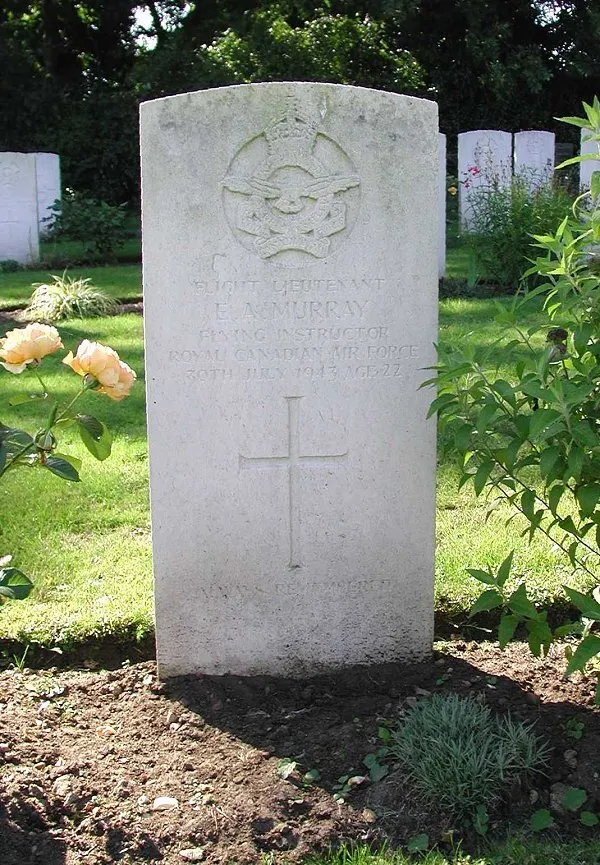
 Oxford Trainer
Oxford Trainer Wikipedia Oxford Trainer
Wikipedia Oxford Trainer Harold A Skaarup Web Page
Harold A Skaarup Web Page